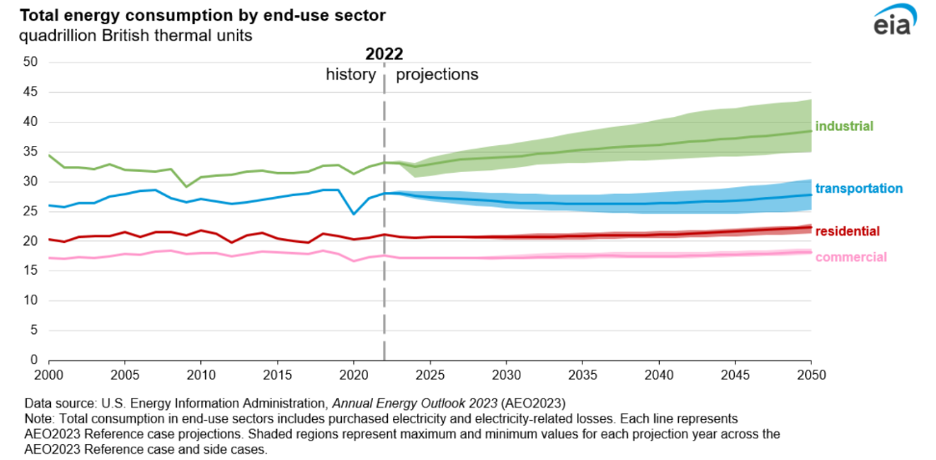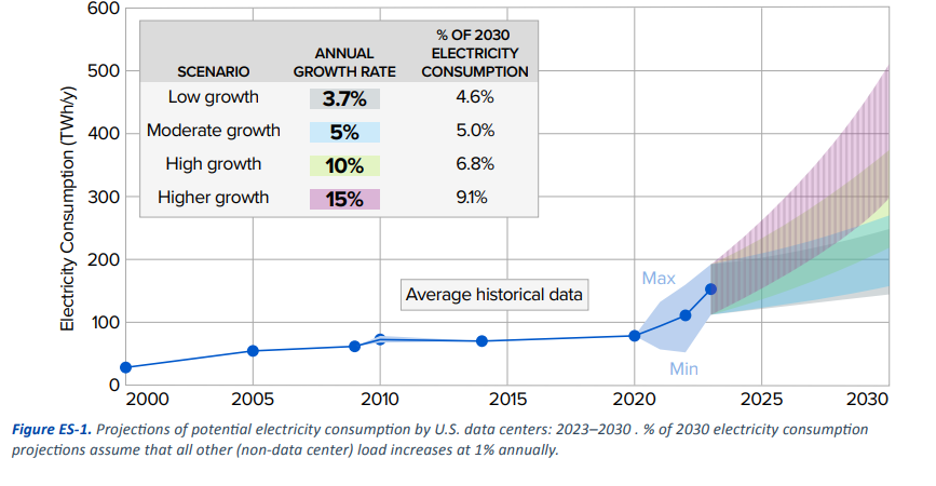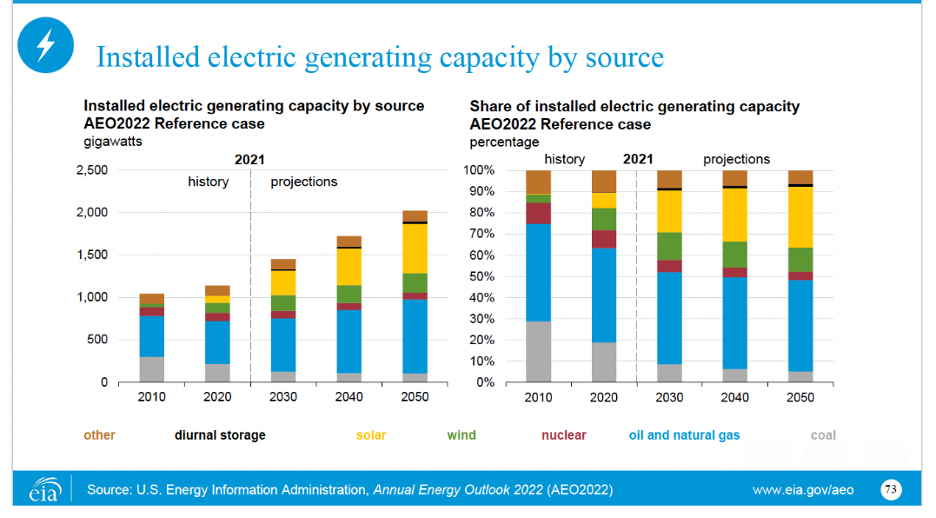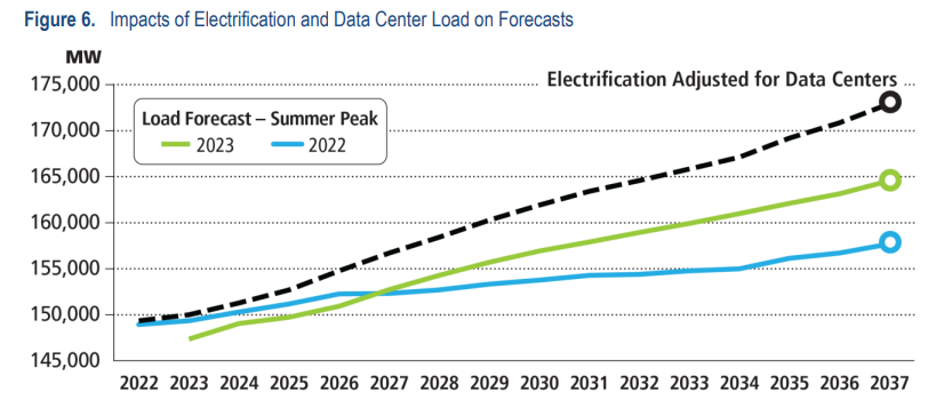News & Media
The Next U.S. Energy Crisis: Electric Power
July 8, 2024
By Bob Martin:
The United States is facing a “perfect storm” of an electric energy crisis that will jeopardize reliability and significantly increase prices over the next two decades. This storm will be fueled by substantial growth in electricity demand, an overly restrictive regulatory environment from the U.S. Environmental Protection Agency (EPA) that will cut existing generation capacity and constrain the growth of new capacity, an energy transition to renewable power that is moving fast (but not fast enough to meet rising demand), and an electric grid that needs massive investments and upgrades. The impending crisis, which could sharply increase electricity prices and could force blackouts in parts of the U.S., requires serious focused action by the Federal and State governments. While cutting carbon emissions and increasing renewable energy development is critical to the U.S. and globally to address climate change, this cannot supersede the priority of protecting U.S. economic growth and energy security, which translates to U.S. national security.
This perfect storm will arise from a convergence of four major competing factors over the next few decades (2024-2050). These factors are as follows:
- Electricity demand in the U.S. will more than double between now and 2050, with demand spiking in the next 5-10 years due to growth of data centers, manufacturing, transportation, electric vehicle (EVs) mandates, and the electrification of homes and businesses;
- The EPA’s recently published final Power Plant Greenhouse Gas (GHG) rules effectively force the closure of all existing base load coal-fired power plants by 2032, and halt any future new investment in efficient low-emitting base load natural gas plants;
- While renewable energy is growing rapidly (and that’s good news), it will not be able to fill the gap created by electricity demand growth and generating plant closures and, consequently, will be unable to provide base load and dispatchable electricity to the grid; and
- The electric grid modernization, upgrade, and expansion is far from ready to support the renewable energy projected to be added during this same time period.
Electricity demand and generation growth in the U.S.
The modeling in the U.S. Energy Information Administration’s (EIA) 2023 Annual Energy Outlook was, at the time of publication, a well-informed projection of both the consumption demand and installed electric generation supply growth as of 2022. The challenge is that several market and regulatory dynamics have changed over the past two years that impact this modeling, and thus, some key assumptions need to be adjusted.
Electric Generating Capacity
The EIA projects that generating capacity will grow annually at 2.4% on average from 2022 to 2050. Overall, it projects that capacity will double, and in most of its modeling cases more than double, between now and 2050. For example, in EIA’s 2022 model, generating capacity goes from about 1,105 gigawatts (GW) in 2022 to 2,172 GW in 2050 in its Reference case. This projection swells to well over 2,500 GW in 2050 in High Economic scenarios. The EIA chart below illustrates that capacity demand growth under several assumptions.

The installed capacity for electricity in EIA’s 2022 model reflects a very significant growth, including that short-term growth is projected to increase over 43% from 2022 to 2032. Renewable energy, primarily solar and wind, with storage are projected to grow at about 5% per year, while baseload generation (coal and natural gas combined) are projected to decline almost 21% between 2022 and 2050.
However, even with the capacity growth, the model still appears to have underestimated the real growth demand curve, especially in the next 10 years. One reason for this is that it does not factor EPA’s new GHG Power Plant rules which will force the closure of virtually all (if not all) the coal units and freeze the growth of any future combined cycle power units. The generation capacity increase also assumes the grid can absorb this growth, especially for renewables. That assumption is proving a challenge with the queue for interconnections (for renewables) backed up for years with most Regional Transmission Organizations.
Electricity Consumption Demand
The EIA projected that U.S. energy consumption will increase in many end-use sectors. They state that “total energy consumption, including electricity use and electricity-related losses, increases by as much as 15% from 2022 to 2050.” The EIA goes on to state that “the largest increases, in percentage terms, are in the industrial sector, where energy consumption increases as much as 32%, and in the transportation sector, where energy consumption increases as much as 8%.” The EIA chart below reflects the maximum and minimum consumption range around the Reference case by end-use sector.

These consumption projections, even at the high end of 15% for all sectors combined, don’t appear to reflect what’s really happening now in 2024. Data centers alone are disrupting the consumption demand.
In Grid Strategies’ December 2023 Report “The Era of Flat Power is Over,” the authors, John D. Wilson and Zach Zimmerman, identify that the “…nationwide forecast of electricity demand shot up from 2.6% to 4.7% growth over the next five years.” Notably, the forecast was based on the recent 2023 FERC filings by grid planners. The report also indicates that “…grid planners forecast peak demand growth of 38 gigawatts (GW) through 2028, requiring rapid planning and construction of new generation and transmission.”
The reason for this dramatic increase is that the rate of electricity consumption growth demand has accelerated over the past two years in four key sectors of the U.S. economy, namely: (1) data centers, (2) manufacturing, (3) transportation, and (4) electrification of homes and commercial businesses.
Data Centers
The growth of data centers in the U.S. has exploded and is now driven by the current and projected use of artificial intelligence (AI) technologies. The Enterprise Power Research Institute (EPRI) recently published a white paper entitled “Powering Intelligence: Analyzing Artificial Intelligence and Data Center Energy Consumption,” (May 2024) in which it developed low, moderate, high, and higher growth scenarios for data center loads from 2023 to 2030. EPRI projects that “[d]ata centers [will] grow to consume 4.6% to 9.1% of U.S. electricity generation annually by 2030 versus an estimated 4% today.” EPRI’s chart below illustrates this demand projection.
EPRI U.S. Data Center Load Projections

Part of this challenge lies in the fact that data centers require huge amounts of energy to both operate and cool the computers in those facilities. The impact of one sector, like data centers, going from using 4% of the electricity demand today to as high as 9% of U.S. electricity consumption by 2030 would significantly outpace any current capabilities or plans for generation growth in the U.S. In addition, AI data centers are expanding into rural areas that typically do not have the electric generation, distribution, or transmission (the grid) infrastructure necessary to support this demand.
Manufacturing
Manufacturing is also growing rapidly in several sectors. For example, in a 2023 online report, “Building America’s Clean Energy Future,” (accessed June 12, 2024) the U.S. Department of Energy identified that over 200 new manufacturing facilities for batteries, HVAC, EVs and transportation, solar, wind, hydrogen, and nuclear industries have been announced since August 2022, when the Inflation Reduction Act (IRA) was passed. While these investments are being made across the nation, the highest concentration appears to be in the Southeast, Midwest and Southwest parts of the U.S.
Manufacturing is also being pushed by the onshoring of industries and domestic content requirements in legislation such as the CHIPS and Science Act of 2022 and the Inflation Reduction Act. The CHIPS and Science Act of 2022 focuses on American manufacturing, supply chains, and national security, and invests in research and development, science and technology (including nanotechnology), clean energy, quantum computing, and artificial intelligence.
Transportation and Electrification
Moreover, the electrification of all aspects of the transportation sector, including rail, cars and commercial vehicles, continues to grow dramatically and elevates the electricity needs in this sector as well. The push for increased electrification in this sector is driven by fuel standards, at the federal level, and mandates for EVs targets at the state level.
Another consideration is that the push for the electrification of homes and commercial businesses, which primarily arises from state mandates, will also increase demand over the next 10-20 years. While this sector is not projected (by EIA) to be burdened by overly dramatic increases, it should be considered as another area of demand for electricity that will need to be accounted for. As the EIA indicates in its report, the EIA Reference Case “assumes that current laws and regulations that affect the energy sector . . . remain unchanged throughout the projection period.” Thus, EIA’s projection for energy consumption does not, and cannot, include data that accurately reflects the ever-evolving nature of state mandates relating to energy demand and consumption. These policy mandates drastically alter the energy landscape each year and, consequently, place additional pressure on an already-overburdened system.
EPA’s new Power Plant GHG Rules
On April 25, 2024, the U.S. Environmental Protection Agency (EPA) published final rules for “stationary sources,” existing coal-fired and new gas-fired power plants that target significantly reducing greenhouse gas (GHG) emissions. While the need to lower carbon emissions in the U.S. is an important goal, these new rules, known as the EPA Power Plant GHG Rules, will effectively force the closure of all exiting existing coal-fired power plants by 2032 and halt any new investment in efficient low emitting natural plants starting today. These rules target Electric Generating Units (EGU) that are connected to the grid. EGUs are base load, which means they run almost 100% of the time to keep America’s lights on. These units are also considered “dispatchable” electricity generation. Dispatchable power is the ability to call upon a specific generation source for immediate use, night or day, to meet electricity demands.
Key provisions of these rules include:
Existing Coal-fired Units For existing coal-fired EGUs, the final rule establishes subcategories based on how far into the future the plant intends to operate.
- Units that intend to operate on or after January 1, 2039, defined as “long-term” units, will have an emission rate limit based on 90% carbon capture by utilizing Carbon Capture/Sequestration (CCS) technology, which they must meet on January 1, 2032.
- Units that have committed to cease operations by January 1, 2039, defined as “medium-term” units, will have an emission rate limit based on 40%, but are required to use natural gas to cofire with coal, which they must meet on January 1, 2030.
- Units that demonstrate that they plan to permanently cease operation prior to January 1, 2032, will have no emission reduction obligations under the rule.
In application, these rules force coal plants to close by 2032 unless they are willing make massive investments in CCS technology, which has yet to be proven at a large scale.
New Natural Gas Units
For new natural gas combustion turbines, the final rule establishes three subcategories based on how intensively they are operated.
- New base load turbines, which would be natural gas combined cycle turbines and are defined as units that generate at least 40% of their maximum annual capacity, will require 90% carbon capture utilizing CCS, with a compliance deadline of January 1, 2032.
- New intermediate load turbines, which are defined as units that generate between 20% and 40% of their maximum annual capacity, are subject to a standard based on efficient design and operation of natural gas simple cycle turbines.
- New low load turbines, typically “Peaker” units, and defined as units that are generating less than 20% of their maximum annual capacity, are subject to a standard based on low-emitting fuel.
Critically, the EPA is required to set standards for stationary sources for new and existing sources based on the “best system of emission reductions” (BSER). The BSER required for coal and gas plants is known as Carbon Capture / Sequestration (CCS) technology. In the final rule, EPA makes the incorrect assumption that “the longer running and more heavily utilized a power plant is, the more cost-effective it is to install controls for CO2 emissions,” meaning Carbon Capture / Sequestration (CCS). However, CCS is unproven on a large scale, is extremely expensive, and requires adequate geologic conditions to store carbon underground. It will also require complex permitting requirements for infrastructure, including wells and CO2 pipelines, as well as supply chain challenges, public opposition, land ownership/access issues.
This all means that new large base load highly efficient natural gas plants are very unlikely to be built for connection to the grid. If EPA’s goal was to create uncertainty about the future of large natural gas combined cycle power plants, they have succeeded. Investments in future natural gas plants will come to a trickle if not a full stop. If they are built, the cost of electricity because of the required CCS technology will be extremely high and passed onto rate payers.
Renewables
Renewables are a critical part of the U.S. energy portfolio and are necessary for long-term energy security and carbon reductions. The good news is that the EIA projects wind and solar energy to account for 44% of the electricity generated by 2050. The EIA chart below illustrates that growth.

The challenge is that renewables (wind and solar) connected to the grid are only about 32% in 2030 and 38% in 2040 of the electricity generated in the U.S. This is not enough to meet the increased energy demand over the next 10-20 years. While growth in renewables is an important part of the solution, it does not appear to be fast enough to fill-in the demand gap, especially if fossil units are forced into early retirement and no new natural gas units are built. In addition, the electric grid is unprepared to take on the electricity generated from renewables.

Another consideration is that most renewables (wind and solar) are intermittent, meaning they are not producing electricity if the wind isn’t blowing, or the sun isn’t shining. This means that they are not dispatchable. However, renewables that are connected to a battery storage system can be dispatchable. For the U.S. to best leverage the full capabilities of wind and solar, large battery storage technology will need to be built at scale over the next several decades to meet the base load needs of the electric grid.
The Grid
The U.S. electric grid is not prepared for significant load growth and, more importantly, has not kept up with the build-out of solar and wind power. Grid Strategies identifies in its December 2023 report that “[t]he U.S. installed 1,700 miles of new high-voltage transmission miles per year on average in the first half of the 2010s but dropped to only 645 miles per year on average in the second half of the 2010s.” Further immediate investment needs to be made to handle the growth demand and to meet the needs of renewable loads for the future.
Grid Strategies also identifies a secondary issue, which is that the “…low transfer capability between regions is a key risk for reliability if load growth outpaces deployment of new generation in some regions.” This means that the Regional Transmission Organizations’ ability to move power on the grid from areas of the country that have excess power to areas of the country that need more power is limited and needs to be significantly upgraded.
EIA notes in its modeling that “…cases with a higher share of renewables in the generation mix have higher total grid capacity due to the inherently lower capacity factors of solar and wind compared with coal, nuclear, and combined-cycle plants. Thus, there will need to be significantly more grid capacity to not just meet demand but to uptake the renewables.”
In its 2022 Energy Transition Report entitled “Resource Retirements, Replacements & Risks,” PJM, a regional transmission organization (RTO) that operates in 13 states from New Jersey to Illinois and the District of Columbia, notes that it is “witnessing a large growth in data center activity.” In addition, the PJM footprint is home to Data Center Alley in Loudoun County, Virginia, the largest concentration of data centers in the world. For example, in 2022, the Load Analysis Subcommittee (LAS) began a review of data center load growth and “identified growth rates over 300% in some instances.”
In addition, “PJM is expecting an increase in electrification resulting from state and federal policies and regulations.” That growth is illustrated in PJM’s Load Forecast below, which demonstrates that, “due to the expansion of data centers, combined with overall electrification, certain individual zones exhibit more significant demand growth—as high as 7% annually.”

The Potential “Gamechangers”
While there are several issues that need to be addressed from a regulatory and investment perspective, there are technologies that could be gamechangers in the next 10-20 years that enhance electricity supply, increase the uptake of renewables, and cut carbon emissions. The most promising technologies involve (1) battery storage, and (2) Nuclear Power/Small Modular Reactors (SMRs).
Battery storage systems allow renewables to be dispatchable. For the U.S. to best leverage the full capabilities of wind and solar, large battery storage technology will need to be built at scale over the next several decades to meet the base load needs of the electric grid. The challenge is that less than 1% (8.8GW) of the power generation assets today are installed large-scale battery storage in the U.S. based on EIA 2022 data.
Nuclear power, given its reliability, cost and zero-carbon emissions, has made a major resurgence around the world, and now in the U.S. While large scale projects remain serious options, the focus in recent years has been around SMRs. According to the European Commission for the Environment, Climate Change, and Energy’s (“ENVE”) online report, “there are more than 80 SMR designs at different stages of development across 18 countries” (last accessed June 27, 2024). SMRs are defined as nuclear reactors that are 300 MW or less, designed with modular technology, built primarily in a factory, and with an approach that provides economies of scale and short construction time. Some of the big names in this space include NuScale, TerraPower, BWXT, Holtec and Westinghouse. The challenge is that SMRs will not be commercially available for 5-10 years, but certainly could fill a large future energy need from 2035-2050.
In Summary
The U.S. needs to take immediate steps in confronting the oncoming “perfect storm” of an electric energy crisis that will jeopardize reliability and significantly increase prices over the next two decades. While still cutting carbon emissions and increasing renewable energy development, it is critical that the U.S. embraces the need to retain and increase electric generation. One aspect of this involves leveraging existing coal assets and encouraging the investment in natural gas combined cycle plants to increase the base load of electricity. By forcing the closure of baseload electricity, the U.S. risks creating an environment for blackouts and price spikes for consumers. In that same vein, the U.S. must reel-in EPA’s overreach on new Power Plant GHG Rules. EPA needs to take a more realistic and measured approach to these rules that recognizes the significant demand for power in the U.S. over the next 25 years.
Most utility executives and numerous policy experts recognize these challenges and are focused on solutions to keep electricity growing as they invest in the transition to renewables. One potential solution is to increase the use of natural gas. Natural gas is and will continue to be critical even as the energy transition to renewables continues. Given the spike in demand over the next few decades, more natural gas will be needed, not less, during this transition.
Reducing carbon emissions and increasing renewable energy development is critical to the U.S. and globally to address climate change. This goal cannot supersede the priority of protecting the country’s economic growth and energy security, and, by extension, national security. Renewable power can and must play a critical role in the long-term energy security of the country but will only be successful in doing so if renewable resources are available to provide baseload electricity, and dispatchable on-demand. At the same time, we need to have a significantly upgraded and modernized electric grid that can efficiently and effectively deliver that power in the future.